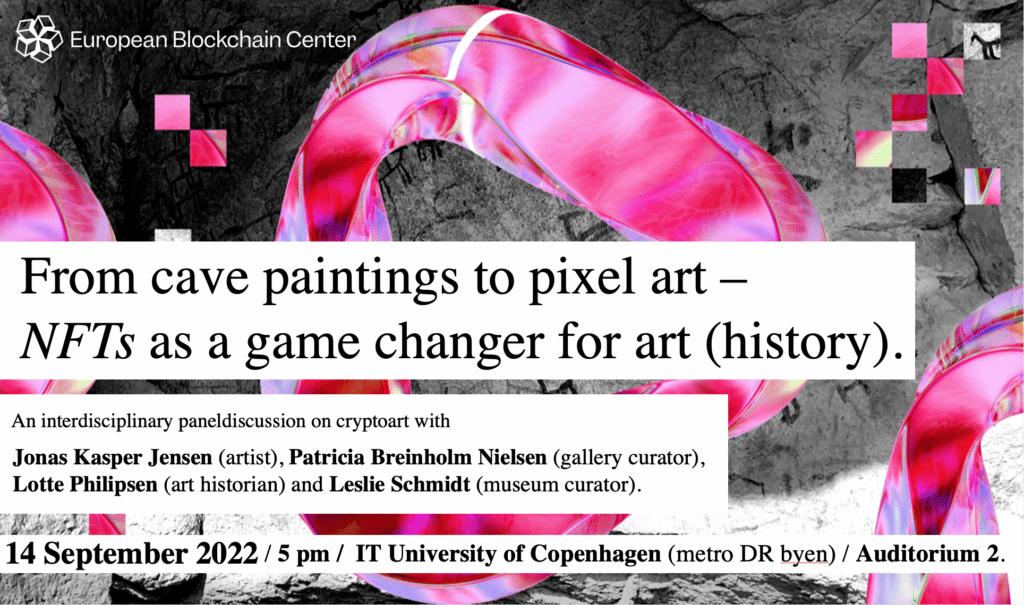In this interview, Hans Brorsen who is an attorney-at-law explains his views on NFTs from a legal perspective. Hans also tells about a panel debate that he is organizing at The European Blockchain Center.
Jonas Kasper Jensen (JKJ): Would you mind telling me about your background?
Hans Brorsen (HB): I’m an attorney-at-law in Berlin, and I studied in Germany, Copenhagen, and London. I specialise in copyright law and I have an interest in blockchain technology also from being a research affiliate at the European Blockchain Center. Hence, I know about the issues within the cross-over of copyright law and NFTs.
JKJ: Do you work with NFTs and blockchain in your practice as a lawyer?
HB: Yes, I get a lot of questions regarding NFTs. My clients ask me what they should be aware of when they buy NFTs, mint NFTs and whilst selling them on marketplaces. Many of my clients do not have that much of a technical or legal understanding of what NFTs and blockchain are.
JKJ: Can you give some examples of client requests regarding NFTs?
HB: The all-time classic questions are: what is an NFT? Why would I pay money for it? And why does it have a value when I can just download the picture? Some people just want to know what a blockchain is and the difference between Bitcoin and a blockchain. I am also often asked why NFTs are relevant. I tell them that, in my opinion, a lot of works from the creative industry will go onto the blockchain and that it’s a liberation of creators and consumers because, with NFTs, they can create and consume art more directly and interact with each other without costly intermediaries.
JKJ: What exactly is an NFT to you?
HB: NFTs are, first of all, a tokenization of the content that they represent, but, in my opinion, they can also be a representation of a license. A license is a contract between two or more parties which allows one of the parties to use the content of the NFT legally so that there’s no infringement of copyright law. As a creator, the interesting thing is that you can now tokenize both the content you’ve created and the license within this very token.
JKJ: Can you give an example of such a license?
HB: A typical license would be that the owner of the NFT can use the protected content as a profile picture. It could also be that you buy the license to commercialise the content, for example, for creating merchandise from the content of the NFT.
JKJ: I know you are the co-organizer of an upcoming panel discussion with this interesting title: From cave paintings to pixel art – NFTs as a game changer for art (history) Do you think – as this title indicates – that NFTs will change art history?
HB: That’s a good question. Honestly, I don’t know. How art was created and consumed hadn’t changed much for years until the internet arrived and became popular. With the internet, suddenly, a lot of homemade art, like, for example, memes, came and was consumed freely, but the traditional art world and the new forms of art that emerged on the internet were not intertwined.
Through the phenomenon of tokenisation with NFTs, suddenly, the old world of traditional art and the new world of internet and digital art start interacting because it has elements of both. So with tokenisation, something similar to the property of digital items starts existing, which resembles the classical world of art. But it is in the metaverse, web 3, cyberspace or whatever you would like to call it. And that’s what I found so interesting about it.
Hans Brorsen is co-organising a panel discussion at The European Blockchain Center called From cave paintings to pixel art – NFTs as a game changer for art (history). At the panel, four different actors from the current art scene will be present and discuss how NFTs might change the art world.

JKJ: So NFTs are to be considered a sort of digital property?
HB: That’s what it’s called inside web 3. But it’s not necessarily property in a legal sense. Smart contracts are also not necessarily proper contracts in a legal sense. But they have the same effect, and people inside the metaverse or in web 3 consider what they hold in their wallet to be property. That’s also an exciting concept because the classical legal definitions of property don’t always match how people interact with each other in web 3.
JKJ: So there’s a new challenge for lawyers, and you must develop new ways to regulate and define what is legally feasible within web 3?
HB: Yes. And that is a challenge for all parties. I believe it is possible to describe something similar as property for NFTs in the legal sense, but it has to be done cleverly and throughout the whole web three ecosystem. There have to be some standards which are compatible and some rules to make a metaverse where everybody can participate on equal terms.
JKJ: Are there already some pitfalls you know those people who want to get involved with NFT technology should know about?
HB: There have already been some cases concerning NFTs, which I consider a good thing because only if cases start existing you can see where the problems are. One example is a case concerned with a person who was minting an NFT where this person did not have the right to do so.
The owners of the original project sued the marketplace. The marketplace was ordered to burn the token, which in a blockchain technological sense is impossible since when you do not have access to the wallet that owns the token, you cannot burn the NFT from the outside. And here, you can already see the old world and the new world are not necessarily compatible. They have two different understandings of how things work, so they collide.
Read other stories: Calo Metaverse Unveils Burn-to-Earn App Calo Indoor as Its Second Project


